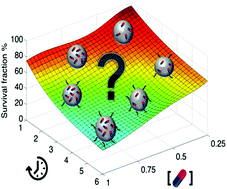An experimental and computational framework for engineering multifunctional nanoparticles: designing selective anticancer therapies†
Abstract
A key challenge in the treatment of cancer with nanomedicine is to engineer and select nanoparticle formulations that lead to the desired selectivity between tumorigenic and non-tumorigenic cells. To this aim, novel designed nanomaterials, deep biochemical understanding of the mechanisms of interaction between nanomaterials and cells, and computational models are emerging as very useful tools to guide the design of efficient and selective nanotherapies. This works shows, using a combination of detailed experimental approaches and simulations, that the specific targeting of cancer cells in comparison to non-tumorigenic cells can be achieved through the custom design of multivalent nanoparticles. A theoretical model that provides simple yet quantitative predictions to tune the nanoparticles targeting and cytotoxic properties by their degree of functionalization is developed. As a case study, a system that included a targeting agent and a drug and is amenable to controlled experimental manipulation and theoretical analysis is used. This study shows how at defined functionalization levels multivalent nanoparticles can selectively kill tumor cells, while barely affecting non-tumorigenic cells. This work opens a way to the rational design of multifunctionalized nanoparticles with defined targeting and cytotoxic properties for practical applications.



 Please wait while we load your content...
Please wait while we load your content...